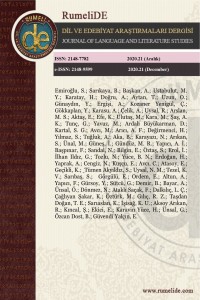Abstract
Sovyet Edebiyatının en önemli yazarlarından biri olan Cengiz Aytmatov, eserlerinde doğup büyüdüğü toprakları, kendi kültürünü yansıtan sözlü edebiyatın en önemli parçaları olan masalları, efsaneleri, mitolojileri kullanır. Bu sayede geçmişle bağ kurduğunu dile getiren yazar, bunun eserlerine ayrı bir güzellik, ayrı bir zenginlik kattığını ifade etmektedir. Eserlerini Rusça ve Kırgızca kaleme alan yazarın gerek hikâyeleri gerekse romanları çok sevilir ve ünü dünyaya yayılır. Bu çalışmada yazarın, 1970 yılında Novıy Mir dergisinde yayımlanan “Beyaz Gemi” adlı romanında öne çıkan dede ve çocuk ikilisinin karakter analizleri yapılmaya çalışılmaktadır. Romanın kahramanı yedi sekiz yaşlarında, ailesi tarafından terk edilmiş bir çocuktur. Yazar, gelenek ve göreneklerinden kopartılmış nesillerin yaşadıkları trajedileri daha iyi anlamamızı sağlamak için çocuğa isim vermek yerine sadece “çocuk” diyerek, okuyucunun dikkatini bu yöne çekip bu çocukların dramını daha net görmemizi istemektedir. Dedesinden başka kimsesi olmayan bu çocuk dedesinin anlattığı Boynuzlu Maral Ana masalına ve kendi kurguladığı Beyaz Gemi masalına inanır. Romanda, torununa masal anlatan, geleneklerine sıkı sıkıya bağlı ve hayatta çok nadir rastlanan mutlu kişilerden olduğu aktarılan Mümin dede geçmişi temsil ederken, çocuk geleceğin temsilcisi konumundadır. Her iki karakter arasında dramatik bir bağ kuran yazar, insana özgü davranışlara farklı yorumlar getirir. Sonuç olarak bu çalışmada, bu iki karakter, metne bağlı inceleme metodu kullanılarak detaylı bir şekilde analiz edildikten sonra, birbirleriyle olan benzer ve farklı özellikleri üzerinde durulmaktadır.
References
- Aybirdi, Murat (2020). Cengiz Aytmatov’un Anlatılarında Su ile Özdeşleşme. Türk Dili, 69 (824): 102-105.
- Aytmatov, Cengiz (2020). Beyaz Gemi. (Çev. Refik Özdek). İstanbul: Ötüken.
- Çetin, Nurullah (2015). Roman Çözümleme Yöntemi. Ankara: Akçağ.
- Mironenko, Y. A. (2012). Folklorno-mifologiçeskiy kontekst povesti Çingiza Aytmatova «Belıy parohod». Vestnik Kazanskogo gosudarstvennogo universiteta kulturyı i iskusstv, (3-2): 115-118.
- Özen, Sabiha (1992). Her Yazar Kendi Halkı İçin Yazmayı Nazarda Tutar, Dergâh, 24: 12-13.
- Uray Akça, Netice (2016). Cengiz Aytmatov’un Romanlarında Tipler. Yüksek lisans tezi. Aydın: Adnan Menderes Üniversitesi, Sosyal Bilimler Enstitüsü.
- Yung, Karl G. (1997). Duşa i mif: şest arhetipov. (Çev. V.V. Naukmanova). Moskova: Port-Royal, Kiev: Soverşenstvo.
Abstract
Chingiz Aitmatov, one of the most important writers of Soviet Literature, tells in his works the land he was born and raised in, the most important parts of oral literature that reflect his own culture, tales, legends and mythologies. Expressing that he established a connection with the past in this way, the author states that this adds a different beauty to his works. The writer, who started his art life by writing a story, later turned to novel. He writes his works in Russian and Kyrgyz. The writer’s not only stories both also novels get very popular and his fame spreads around the world. In this study, the character analysis of the grandfather and child duo, who came to the fore in the novel “The White Ship” published in Novy Mir magazine in 1970, is tried to be made. The main character of the novel is a seven or eight year old boy abandoned by his family. The author wants us to draw the attention of the reader to this direction and see the drama of these children more clearly by saying "child" instead of naming the child in order to make us better understand the tragedies experienced by the generations separated from their traditions and customs. The child, with no one but his grandfather, believes in the fairy tale The Horned Mother, told by his grandfather, and the tale of The White Ship that he fictionalized. While the grandfather Momun, who is strictly committed to the traditions of telling stories to his grandchild and is a very rare happy person in life, represents the past, the child is the representative of the future. Establishing a dramatic link between both characters, the author makes different interpretations of human behavior. In conclusion, in this study after these two characters are analyzed in detail using the text-based analysis method, their similar and different characteristics with each other are emphasized.
Keywords
References
- Aybirdi, Murat (2020). Cengiz Aytmatov’un Anlatılarında Su ile Özdeşleşme. Türk Dili, 69 (824): 102-105.
- Aytmatov, Cengiz (2020). Beyaz Gemi. (Çev. Refik Özdek). İstanbul: Ötüken.
- Çetin, Nurullah (2015). Roman Çözümleme Yöntemi. Ankara: Akçağ.
- Mironenko, Y. A. (2012). Folklorno-mifologiçeskiy kontekst povesti Çingiza Aytmatova «Belıy parohod». Vestnik Kazanskogo gosudarstvennogo universiteta kulturyı i iskusstv, (3-2): 115-118.
- Özen, Sabiha (1992). Her Yazar Kendi Halkı İçin Yazmayı Nazarda Tutar, Dergâh, 24: 12-13.
- Uray Akça, Netice (2016). Cengiz Aytmatov’un Romanlarında Tipler. Yüksek lisans tezi. Aydın: Adnan Menderes Üniversitesi, Sosyal Bilimler Enstitüsü.
- Yung, Karl G. (1997). Duşa i mif: şest arhetipov. (Çev. V.V. Naukmanova). Moskova: Port-Royal, Kiev: Soverşenstvo.
Details
| Primary Language | Turkish |
|---|---|
| Subjects | Linguistics |
| Journal Section | World languages, cultures and litertures |
| Authors | |
| Publication Date | December 21, 2020 |
| Published in Issue | Year 2020 Issue: 21 |

